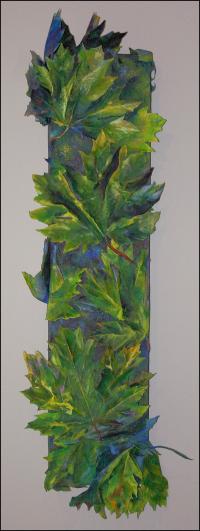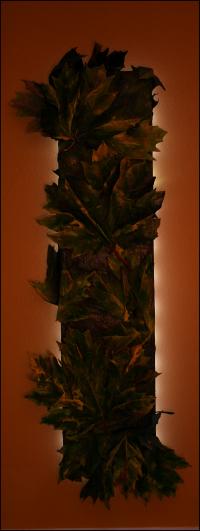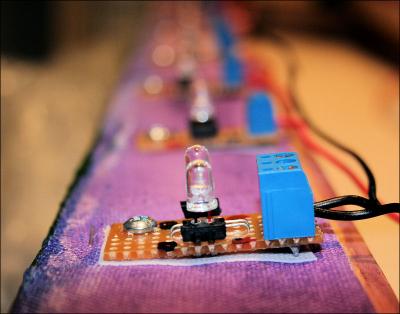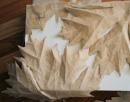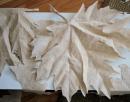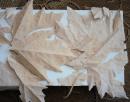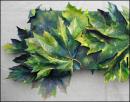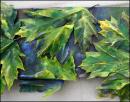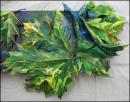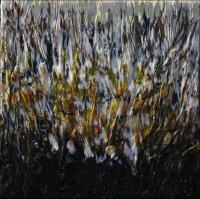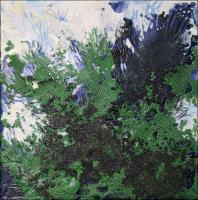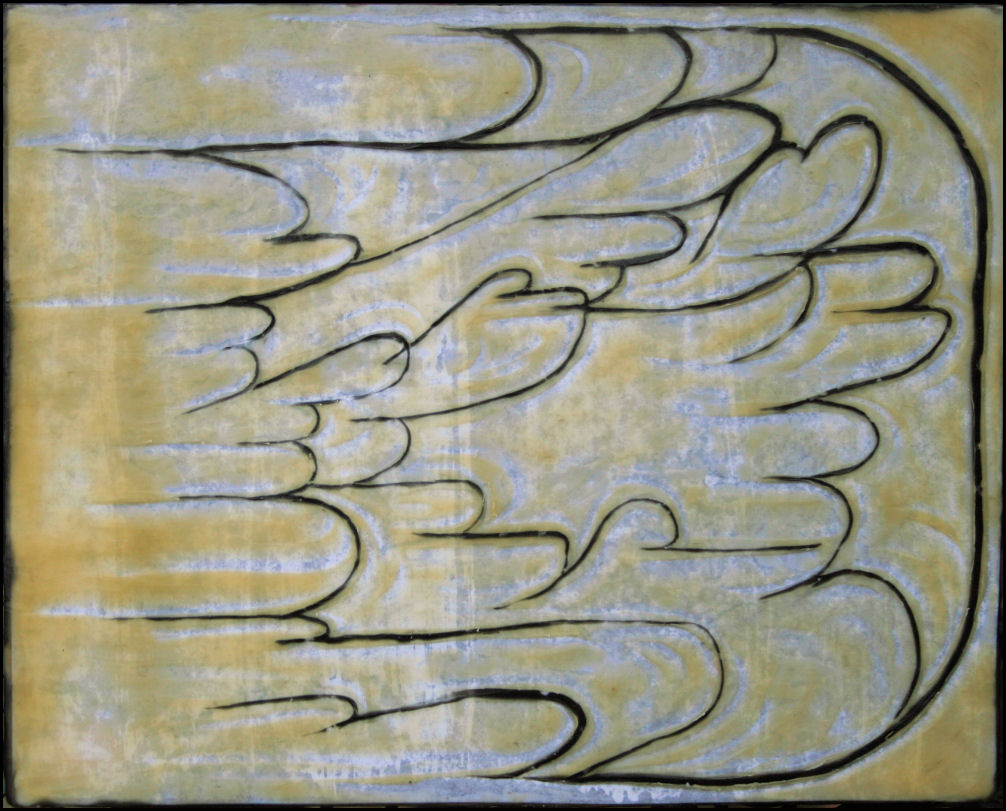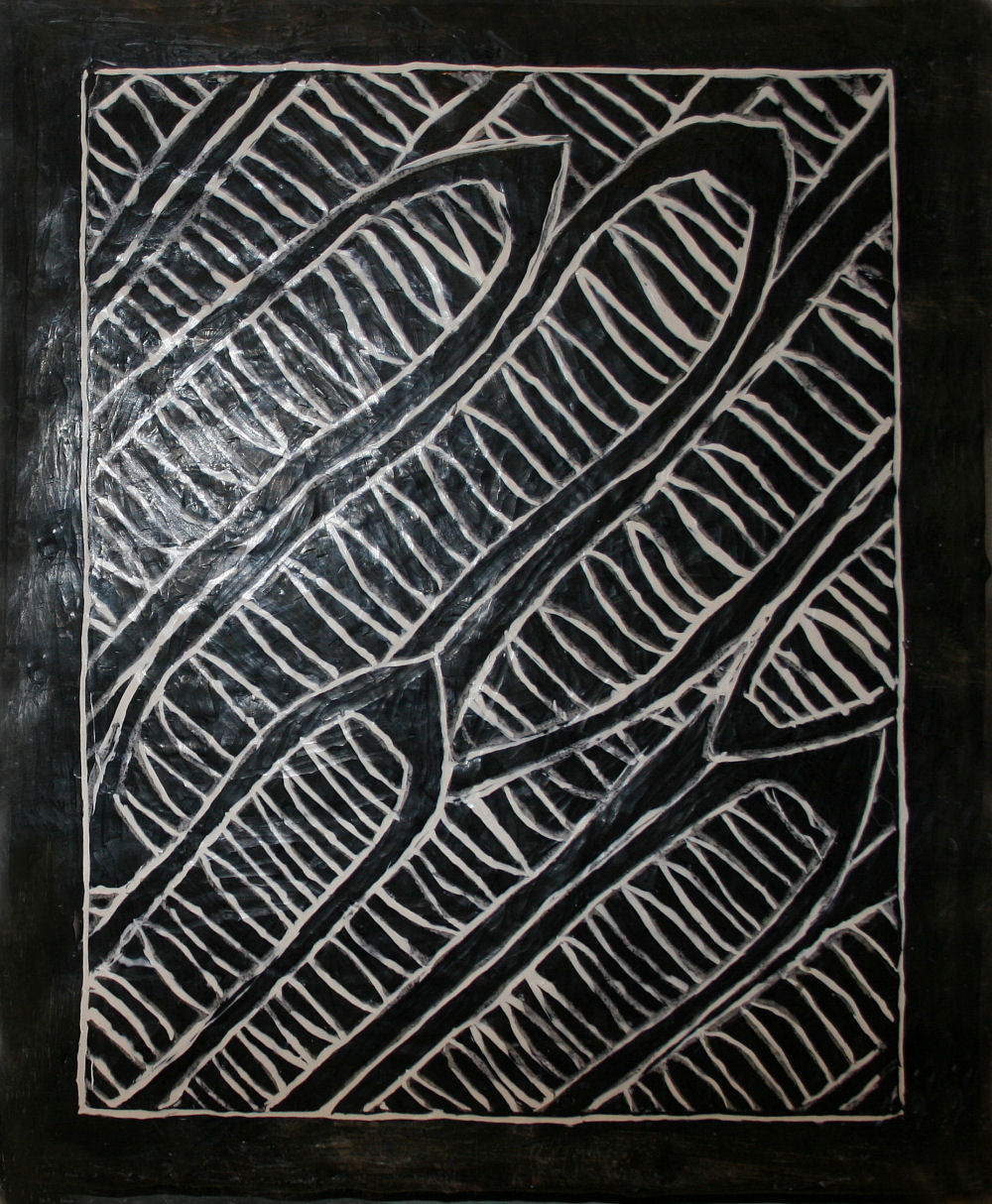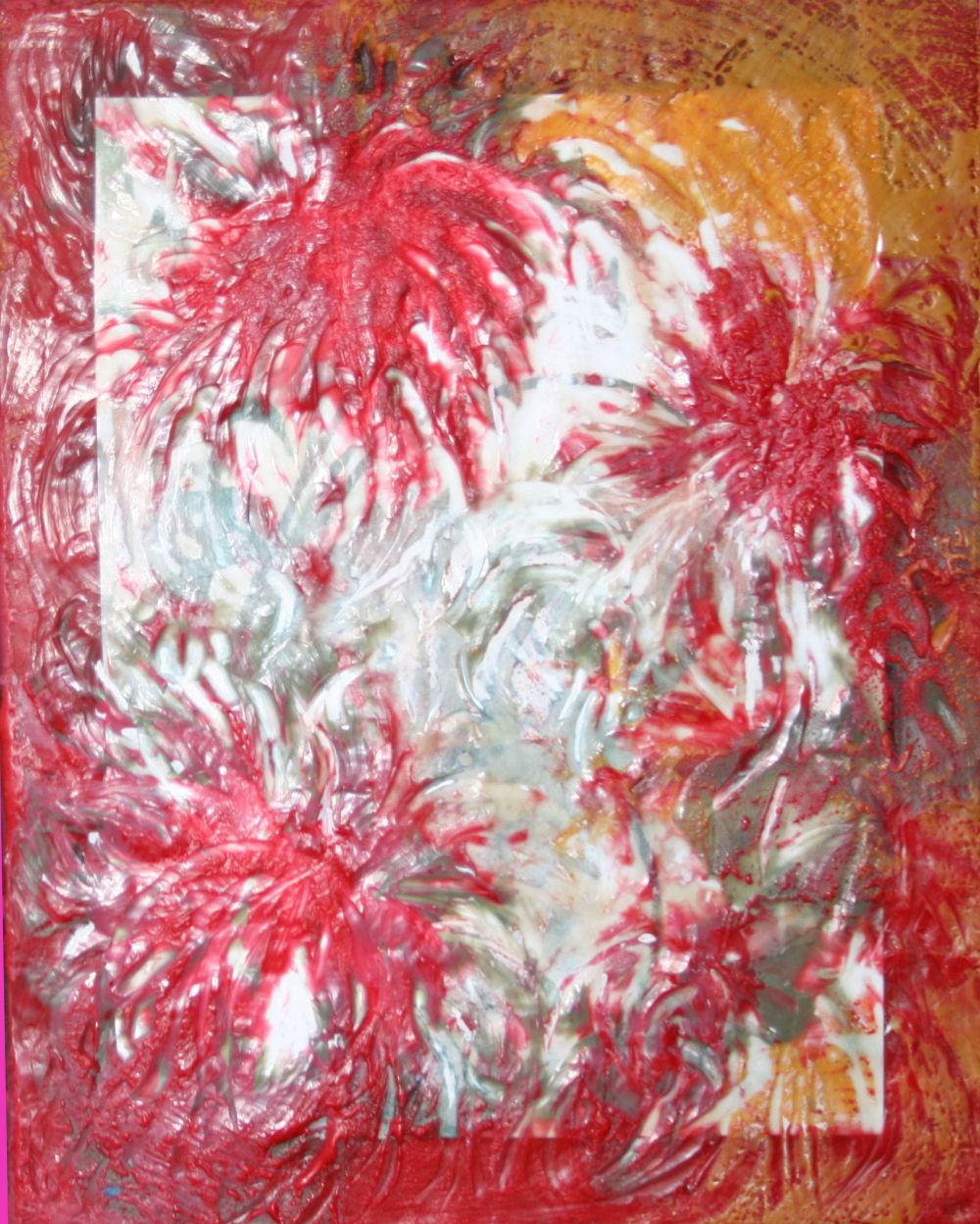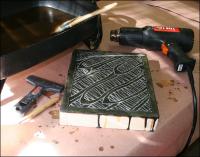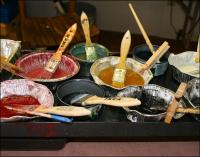Encaustic
What Bigleaf Maples Do At Night
Monday, May 25th, 2009
What Bigleaf Maples Do At Night, 57H x 20W x 4D inches muslin, glue, acrylics on canvas wrapped over custom-built stretcher frame. LED light system in back.
Alain, my husband, signed his name on this also, because he spent the entire week designing, soldering and wiring a system of 30 LED lights for the back. He was not impressed with the eight inadequate push-lights I was initially going to use to create this Day- Night Art. The electric source is a rechargeable 12 volt battery placed neatly in the back, with an easily accessible on-off switch in the lower left corner. He’s not thrilled to ever create another, so it looks like I’ll be learning a little about soldering and electronics, because there are plans to transform the other two canvases exactly the same size as this one. Originally l hoped it could hang in any of four orientations, but that was revised due the battery pack in the back. Thank you Alain for making this piece what it is!
______________________The original blog posts; process:___________________
Nov. 17th, 2008: While finishing the final stages of Sun Shower #4, at this point more study than stroke, I’ve started on the next piece… a bit of mystery thrown into this one just for fun. Hint: Step 1 – Unbleached muslin is painted with glue; place over top parchment paper and turn or lift frequently so it doesn’t stick. Nov. 18th: Step 2– When dry the muslin becomes stiff and can be crumpled, pinched and maneuvered to create 3D textures.
Nov 18th, aft. Step 3 – OK, enough guessing. I have three beautiful sturdy 36 x 12 x 3 inch canvases, hung vertically or horizontally. Each one will have a 3D design of life-sized leaves created with the stiff muslin. This one is of Large Leaf Maples seen on salt Spring Island, B.C. when we were there last summer. They are really this big – about 15 inches across! On these canvases, all dimensional surfaces will be considered; the front, the sides, and possibly some sticking out from the back. Everything will be primed before painting and I love Virginia’s idea to use glue as a resist for the leaf veins. In the above three images the design is still in planning stages.
Nov. 19th – A few thoughts before continuing work: this could be as simple as a sillhouette or painted realistically, still haven’t decided..maybe a compromise of the two, on the abstract side of things. Putting lights in the back could be interesting too, as in the recent Zen Garden #8 but would like to come up with something that does not have a distracting cord.
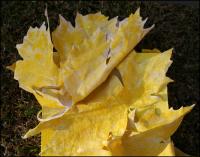 Nov.21st – Seen here, the leaves have a splotchy base coat of Hansa Yellow Deep, a color chosen because when it is so vibrant when it peeks through built up layers of other colors. Now that the entire piece has color though, I think I prefer the sculptural purity of the unpainted sillhouettes better – something to remember for similar work in the future.
Nov.21st – Seen here, the leaves have a splotchy base coat of Hansa Yellow Deep, a color chosen because when it is so vibrant when it peeks through built up layers of other colors. Now that the entire piece has color though, I think I prefer the sculptural purity of the unpainted sillhouettes better – something to remember for similar work in the future.
The weight of tinted primer and each application of acrylics makes the fabric limp from of the paint, meaning the creasing process needs to be done all over again once it dries, even on successive layers. Because of this I need to slow down and be more gentle with the painting process also. It’s funny how you can overlook things like that when you are ten steps ahead with anticipation for a new project; things always take much longer than you imagine. There is going to be a lot of stopping and starting with this one, which is exactly how overlapping projects occurs.
Also: looking forward to a day-long workshop tomorrow, learning about Encaustic painting with Deanna Wood. Encaustics is an ancient process of painting with beeswax and natural resins. Not usually a “workshop” kind of Artist because I’m too greedy with my work-time, but this is one of those things that’s best learned from an expert. Am bringing a fabric leaf to the class to see how it could be incorporated and if this entire. Large Leaf Maples piece could benefit.
______________________________
All posts and comments for this piece are now combined.
Submitted on 2008/11/18 at 11:48am
If you don’t want to see the seed bits in the muslin, you can get unbleached muslin without the seeds.
_______________________________
Submitted on 2008/11/18 at 1:03pm
OK Lynda, thanks for offering this valuable tip. With regard to what’s in mind for this project, the rawness of the fabric will provide extra texture, but others may want to know that finer quality muslin is available.
Nikki
_______________________________
Submitted on 2008/11/18 at 1:53pm
Hmmm…looks like a resist process to me. Is it a mask? You are a very adventurous soul!
Virginia Wieringa
_______________________________
Submitted on 2008/11/18 at 2:06pm
Nope, not a mask or resist…at least the glue wasn’t initially going to be used as a resist, but once again I owe thanks for the tip via a viewer’s comment – thanks Virginia! It’s true, glue can be used on anything as a paint resist, usually on wood it works similar to crackle glaze (ask me how if anyone is interested). I haven’t tried that technique on raw fabric yet though and for what I have in mind, painting extra glue in strategic places could produce some interesting effects. Let’s see…
Nikki
_______________________________
Submitted on 2008/11/19 at 1:16am
This is great Nikki. I’ll be back tomorrow to see how this project is coming along.
Jim Drury
_______________________________
Submitted on 2008/11/19 at 4:12pm
Hi Nikki
This is getting really interesting, can’t wait to see the finish project
Elizabeth
_______________________________
Submitted on 2008/11/19 at 7:07pm
Thanks for staying tuned Dad and Elizabeth, I also can’t wait to see the finished project – it’s always a mystery even if I think I know what I’m doing.
Nikki
_______________________________
Nov.27: What Large Leaf Maples Do At Night, detail images of 12 x 36 x 3 inches Muslin, glue, acrylics on wrapped canvas. As seen here I imagined the leaves glowing in the moonlight, which took me to the idea of turning it into a piece that can be viewed differently in a dark corner or at night so the sculptural sillhouette shows best.
Since Saturday’s Encaustics workshop I’d like to try another sculptural piece doing the whole thing with 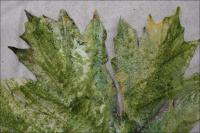 Encaustics tecniques, see right sample. Beeswax doesn’t adhere to acrylics though, so another will need to be planned with that medium in mind right from the start.
Encaustics tecniques, see right sample. Beeswax doesn’t adhere to acrylics though, so another will need to be planned with that medium in mind right from the start.
Branching Out
Friday, March 20th, 2009
Branching Out and Conifer, each 6H x 6W x 2D inches Encaustic, side surfaces also done.
Encaustic is designing/painting with beeswax. I’m not usually intimidated by trying any new medium, but wax is so unique and there are so many possibilities for it, I was a little overwhelmed when I took an introductory course with Deanna Wood. She offers her students workshop days where they can use her supplies to continue experimenting with the medium. Although I’d love to have my own supplies to work at home, the encaustic process is so messy, not to mention expensive to get started, so that is a generous offer. Today’s studio work produced 4 small encaustic paintings, and 2 are successful. Compared to other media, wax is so versatile it can be scraped off to whatever degree, reworked, layered, carved and manipulated as much or as long as you wish. It’s a lot of fun!
Encaustic – painting with beeswax
Friday, January 16th, 2009
Windy Maple Leaves, 8H x 10W x 2D inches encaustics
1) design inspired by Flamboyant Tree Seed Pods, white beeswax inlay on black, and 2) using a print of an old painting Dahlias as a base, techniques were more spontaneous, each 10H x 8W x 2D inches encaustics
Encaustic Artist Deanna Wood offers her studio space and supplies to her students on days when she’ll be there working. It’s a bargain for $30 per day so I went yesterday and finished the two pieces above. Painting with wax is a messy process, and Deanna’s studio is all set up for it, so it’s a perfect arrangement for artists who work primarily in other mediums, who don’t yet have their own supplies and wish to continue exploring encaustics. BYOS – Bring your own surface!
With a FAQ page on her website, Deanna outlines a brief history about encaustics and herself. Her most recent solo exhibition displays a portion of the extensive amount of encaustic works created around the theme of tornadoes. Including a few multi-media pieces as well, the show runs January 10th – February 29th, 2009 at the Leslie Powell Foundation and Gallery in Lawton, Oklahoma.


